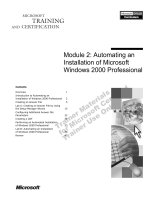Tài liệu Module 2: Team Model docx
Bạn đang xem bản rút gọn của tài liệu. Xem và tải ngay bản đầy đủ của tài liệu tại đây (500.3 KB, 42 trang )
Module 2: Team Model
2
THIS PAGE LEFT INTENTIONALLY BLANK
0RGXOH#5=#7HDP#0RGHO##5²6
2EMHFWLYHV
At the end of this module, you will be able to
„
Understand the challenges of traditional teaming
„
Understand the rationale behind the team model for
infrastructure deployment
„
Understand the team model’s roles and
responsibilities
„
Understand some underlying team model principles
„
Understand how to scale the team model for large and
small projects
„
Understand the risks involved in combining
roles
5²7# # 0RGXOH#5=#7HDP#0RGHO
/HVVRQV
Lessons
1. Teaming Concepts
2. Underlying Team Principles
3. Team Model for Infrastructure Deployment
4. Scaling the Team Model
0RGXOH#5=#7HDP#0RGHO##5²8
/HVVRQ#4=#7HDPLQJ#&RQFHSWV
Lesson 1:
Teaming Concepts
The disadvantages of
traditional teams
5²9# # 0RGXOH#5=#7HDP#0RGHO
$FWLYLW\=#&RPPXQLFDWLQJ#LQ#7UDGLWLRQDO#7HDPV
,Q#VPDOO#WHDPV=#
Activity
„
Arrange your chairs according to the diagram
„
Read through your role sheet
„
Communicate your choices on notepaper
(addressed according to instructions) through your
team messenger
„
When your team has the answer, raise your hand
0RGXOH#5=#7HDP#0RGHO##5²:
'LVDGYDQWDJHV#RI#7UDGLWLRQDO#7HDPV
„
High communications overhead
„
Misunderstandings from indirect
communications
„
Unclear team goals
„
Disengaged team members
„
High process overhead
The traditional team structure has certain disadvantages that the MSF team
model is designed to overcome:
„
The traditional structure imposes a relatively high overhead, which inhibits
communications.
„
Team members will not communicate clearly unless they understand their
roles and the roles of others on their team.
„
Team members who do not communicate directly increase their chances of
being misunderstood.
„
Team members are likely to disengage if they do not understand what is
happening or where they are going.
5²;# # 0RGXOH#5=#7HDP#0RGHO
3URMHFW#7HDPV#DW#0LFURVRIW
Principles
„
Small, multidisciplinary teams
„
Interdependent roles and
shared responsibilities
„
Deep technical and business acumen
„
Focus on competency and a
product mindset
„
Clear goals and objectives
„
Active customer participation
Here are some of the 12 fundamental concepts and principles that project teams
at Microsoft follow:
„
Teams are small, consisting of three to eight members who work in parallel
as part of the team.
„
Team members are given broad, interdependent, and overlapping roles, and
share responsibility for the success of the project.
„
Team members are selected on the basis of their deep understanding of the
technology involved.
„
The team focuses on competency and maintains a product mindset, which
will be explained later in this module.
„
Each disciplinary role on the team has clear goals and objectives for its
participation on the team.
„
Teams incorporate customer feedback continuously throughout the project.
0RGXOH#5=#7HDP#0RGHO##5²<
3URMHFW#7HDPV#DW#0LFURVRIW#
+FRQWLQXHG,
Principles
„
Shared project vision
„
Full participation in design
„
Deliberate efforts to learn from
past projects
„
Shared project management
and shared decision-makin
g
„
Team members working
together at one site
„
Large teams working like
small teams
The following are additional principles for project teams at Microsoft:
„
Everybody on the project team must share a common vision as to what the
solution should encompass and what combination of factors constitutes
success for the project.
„
Every team member brings an individual perspective to the design by
contributing it to the product specification.
„
After every milestone, teams conduct a review to highlight lessons learned,
determining what went well and what could have gone better.
„
Members share project management and decision-making responsibilities.
„
Experience has proven that when team members are close enough
physically to solve problems face to face, the outcome of the project is
consistently higher.
„
Large teams are broken down into small, multidisciplinary feature teams
and centralized function teams, which will be explained later in this module.
5²43# # 0RGXOH#5=#7HDP#0RGHO
THIS PAGE LEFT INTENTIONALLY BLANK
0RGXOH#5=#7HDP#0RGHO##5²44
/HVVRQ#5=#8QGHUO\LQJ#7HDP#3ULQFLSOHV
Lesson 2:
Underlying Team
Principles
Some of the principles and
practices that make the
team model successful
5²45# # 0RGXOH#5=#7HDP#0RGHO
3ULQFLSOHV#RI#D#6XFFHVVIXO#7HDP
„
Shared project vision
„
Product mindset
„
Zero-defect mindset
„
Customer-focused mindset
„
Willingness to learn
We will explore each of these principles in detail in the following slides.
0RGXOH#5=#7HDP#0RGHO##5²46
6KDUHG#3URMHFW#9LVLRQ
„
What it means
„
Clearly understanding
project goals and objectives
„
Understanding and buying
into a vision that all team members and the
customer hold
„
Why it is important
„
Provides the team with a uniform sense of purpose
„
Resolves conflicting and contradictory visions
„
Clarifies project goals and objectives
„
Ensures that team members are working toward
the same goal
A project’s success depends on the ability of project team members and the
customer to share a clear understanding of the project’s goals and objectives.
The vision should be formalized as a vision statement that describes both what
the project is and is not, enables decisions, motivates the team, and is
achievable. Shared vision helps eliminate conflicting visions, which enhances
the team’s cohesiveness.
Having a vision offers a way to measure success. By coming to agreement on
what the project is and should accomplish, every role can work toward a
common goal.
5²47# # 0RGXOH#5=#7HDP#0RGHO
3URGXFW#0LQGVHW
„
What it means
„
Treating the solution as
a product
„
Treating the final deliverable
of the project as a total solution:
a product
„
Why it is important
„
Focuses the team on execution
rather than process
„
Enables the team to use a
versioned release strategy
„
Increases team identity and
accountability
MSF advocates creating project identities so resources see themselves less as
individuals and more as members of a project team.
A product mindset allows the team to use a versioned release strategy to
prioritize features, change issues, and deploy the solution in a timely manner.
Versioned releases will be covered in detail later in this course.
Focus on execution does not mean that process is bad, but that it should be used
to accomplish the goal, not just for the sake of using process.
0RGXOH#5=#7HDP#0RGHO##5²48
=HUR0'HIHFW#0LQGVHW
„
What it means
„
Committing to quality
„
Performing work at the highest
possible level of quality
„
Focusing on achieving the quality bar set by
the team
„
Why it is important
„
Increases solution stability
„
Increases schedule predictability
„
Improves accountability
A zero-defect mindset is a commitment to do work at the highest quality
possible at the time it is being done. If each team member does the best job
possible on his or her part, that will raise the overall quality of the product.
Quality has to be owned individually, and not delegated. Every team member
must have a stake in the quality of the deployed solution.
The zero-defect mindset is not about deploying a solution with no defects at all.
Team members should work toward perfection, even if the theoretical concept
of “perfection” is not always possible to attain.
5²49# # 0RGXOH#5=#7HDP#0RGHO
&XVWRPHU0)RFXVHG#0LQGVHW
„
What it means
„
Committing to understanding and
solving the business problem
„
Focusing on the alignment of business
and technology
„
Involving the customer throughout the process
„
Why it is important
„
Increases focus on customer needs, which
improves ability to solve the business problem
„
Focuses innovation on solving the business
problem
Having the customer actively participate in and offer feedback throughout the
deployment process allows the team to better manage customer expectations
and achieve a better alignment with customer needs. This involves choosing the
technology that aligns best with those needs and developing a deployment plan
that is focused on solving the business problem. The ability to trace every
component of the solution back to a customer or user requirement offers a way
to measure success.









